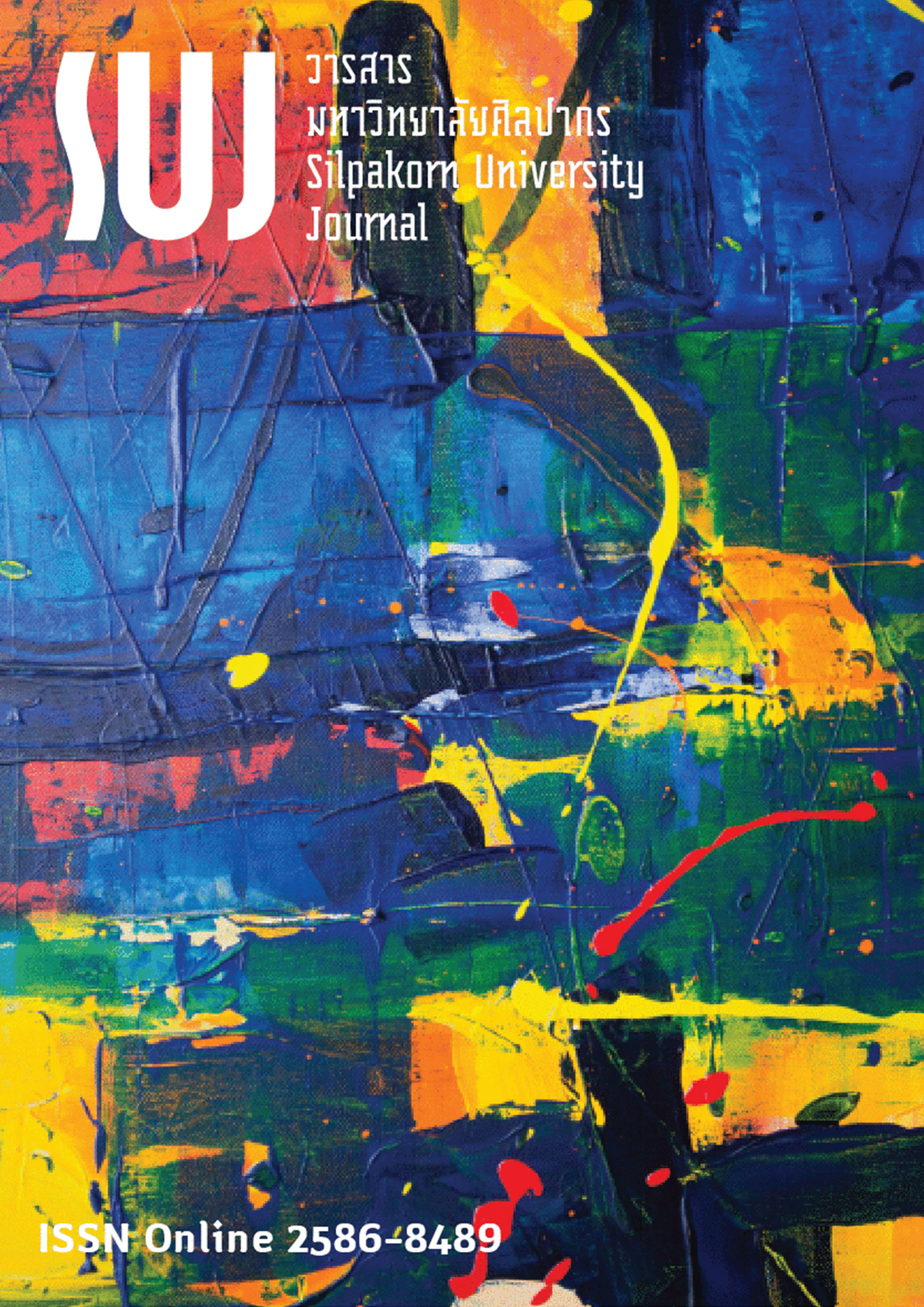การสร้างบทละครรำ เรื่อง พระสุริโยทัย ตอน พระสุริโยทัยลงสรงทรงเครื่องรบ (A creation of Thai dance drama on “Prasuriyothai Longsong Songkreuang Rop”)
Main Article Content
Abstract
บทความวิจัยนี้เป็นส่วนหนึ่งของวิทยานิพนธ์ เรื่อง ละครรำ เรื่อง พระสุริโยทัย มีวัตถุประสงค์เพื่อสร้างบทละครรำ เรื่อง พระสุริโยทัย ตอน พระสุริโยทัยลงสรงทรงเครื่องรบ มีวิธีดำเนินการวิจัยด้วยระเบียบวิจัยเชิงคุณภาพ โดยวิธีการศึกษาค้นคว้าวรรณกรรม บทละครโบราณ พระราชพงศาวดาร งานวิจัย พระตำหรับนุ่งผ้าขี่ช้าง นำการสัมภาษณ์และหลักการประกอบสร้างงานศิลปกรรมมาศึกษาวิเคราะห์และเลือกใช้เป็นต้นแบบในการทรงเครื่องรบของพระสุริโยทัย วีรสตรีที่แต่งกายอย่างพระมหาอุปราชเพื่อเดินทางไปดูเชิงข้าศึกร่วมกับพระมหาจักรพรรดิ ผลการวิจัยพบว่า ในการสร้างบทละครรำ เรื่อง พระสุริโยทัย ตอนพระสุริโยทัยลงสรงทรงเครื่องรบ ต้องทำการศึกษาพระราชประวัติพระสุริโยทัย วิเคราะห์การแต่งกายของพระสุริโยทัยตามที่ปรากฏในพระราชพงศาวดาร และการนุ่งผ้าทรงช้างของพระมหากษัตริย์ตลอดจนอาวุธที่ใช้และพาหนะที่ทรง นอกจากนี้ต้องศึกษาบทละครพระราชนิพนธ์ เรื่อง อิเหนา ในรัชกาลที่ 2 ด้านความงามของภาษาและจารีตในราชสำนักเพื่อนำมาเป็นต้นแบบและนำขั้นตอนสำคัญในการลงสรงทรงเครื่องมาวิเคราะห์เพื่อสร้างบทละครรำ จากนั้นดำเนินการสร้างบทละครรำด้วยหลักการประกอบสร้างงานศิลปกรรมของศาสตราจารย์กิตติคุณ ดร.สุรพล วิรุฬห์รักษ์ โดยกล่าวถึงขั้นตอนในการลงสรงทรงเครื่องรบ บอกถึงวัตถุประสงค์ในการปฏิบัติภารกิจ ขั้นตอนการลงสรงทรงเครื่อง ได้แก่ การสรงน้ำ การทรงสุคนธ์ การทรงเครื่อง นมัสการพระขอพรสิ่งศักดิ์สิทธิ์ ทรงพระมาลา ทรงพระแสงของ้าว และเทิดพระเกียรติพระสุริโยทัยในบทสุดท้าย เพื่อเป็นการประกาศพระเกียรติคุณบูรพกษัตรีย์ในรูปแบบบทละครใน นอกจากนี้ยังสามารถเป็นแรงบันดาลใจ ก่อให้เกิดการต่อยอดทางวัฒนธรรมในการสร้างสรรค์บทละคร โดยนำเรื่องราวทางประวัติศาสตร์อันทรงคุณค่ามาถ่ายทอดเป็นวรรณกรรมและนาฏกรรมเพื่อให้ชนรุ่นหลังได้รับรู้ถึงคุณงามความดีของบรรพบุรุษสืบไป
This research article is part of a thesis entitled “Dance Drama of Queen Suriyothai.” It aims to create a written Thai dance drama on “Queen Suriyothai: an episode of Queen Suriyothai’s taking a bath and dressing for a battle.” It is qualitative research that involves studying literary works, ancient plays, royal annals, research work, a manual of royal dressing for elephant riding; interviewing; and employing the creativity theories as analysis tool in choosing master model in clothing for battle of Queen Suriyothai. Queen Suriyothai as the heroine dressed as the viceroy for battle observation with the emperor. The findings showed that in creating a written dramatic dance entitled “Queen Suriyothai: an episode of Queen Suriyothai’s taking a bath and dressing for a battle”, it was necessary to study the biography of Queen Suriyothai and analyze her dressing style as appeared in the royal chronicles, her dressing pattern for riding the King’s elephant as well as the weapons and vehicles used in ancient battles. Moreover, to create the dance drama, there was the need to study King Rama II’s play I-Nao on its aesthetic of language and royal customs in order to use it as a model and to analyze the process of bathing and dressing. From the study, the dance drama was then created in accordance with the principle of performing arts creation of Professor Emeritus Dr. Surapone Virulrak, which explained the process of bathing and dressing for a battle and the purpose of the mission. The processes of bathing and dressing included bathing, wearing pleasant scent, and dressing: 1. Showering 2. Taking Sukhon 3. Clothing together praying and asking the blessing the holy things for taking the hat worn of the king and Phra Saeng kor ngow weapon and to honor Queen Suriyothai.
Downloads
Article Details

This work is licensed under a Creative Commons Attribution-NonCommercial-NoDerivatives 4.0 International License.
References
Buddha Loetla Nabhalai, His Majesty King. (1971). I-Nao Dramatic Composition (บทละครเรื่องอิเหนา) (11th ed.). Thonburi: Rungwattana Printing House.
Damrong Rajanubhab, Somdet Phrachaoboromwongthoe Kromphraya. (1964). Legend of I-Nao Drama (ตำนานละครอิเหนา) (3rd ed.). Pranakorn: Klangwittaya.
Panjantanumas (Jerm). (1969). Chronicle Meeting Volume 38 (Conference Chronicle Part 64) Ayutthaya Chronicle Panchanthanumat (Jerm) Edition (ประชุมพงศาวดาร เล่ม 38 (ประชุมพงศาวดาร ภาคที่ 64) พงศาวดารกรุงศรีอยุธยา ฉบับพันจันทนุมาศ (เจิม)). Bangkok: The Printing House of the Teachers’ Council.
Sasiwannapong, Poomthai. (2020). The Study of Armor of Warriors in Thailand Before the 24th Buddhist Century (การศึกษาเรื่องชุดเกราะของนักรบ ในประเทศไทย ช่วงก่อนพุทธศตวรรษที่ 24). [Online]. Retrieved July 1, 2021 from https://www.silpa-mag.com/history/article_8054
The Royal Institute. (2013). The Royal Institute’s Dictionary B.E. 2554 (พจนานุกรมฉบับราชบัณฑิตยสถาน พ.ศ. 2554). Bangkok: The Royal Institute.
Vajirayana. (1938). The Text of Elephants Part 1/The Manual of Royal Dressing for Elephant Riding (พระตำหรับนุ่งผ้าขี่ช้าง). [Online]. Retrieved July 1, 2021 from https://shorturl.asia/ADM7e
Virulrak, Surapone. (2004). Thai Dance Performing Principle Review (หลักการแสดงนาฎยศิลป์ปริทรรศน์). Bangkok: Chulalongkorn University Press.
Interviews
Trakulngernthai, Weeratham, Founder of Yok Thong Chansoma woven group, Surin province and Creator of the costume, decorations and accessories in the Royal Khon Pantomime. Interview, July 20, 2021.
Vingvorn, Sauvanit, Department of Literature, Faculty of Humanities, Kasetsart University. Interview, March 17, 2021.
Virulrak, Surapone, President of the Royal Society. Interview, June 30, 2021.


